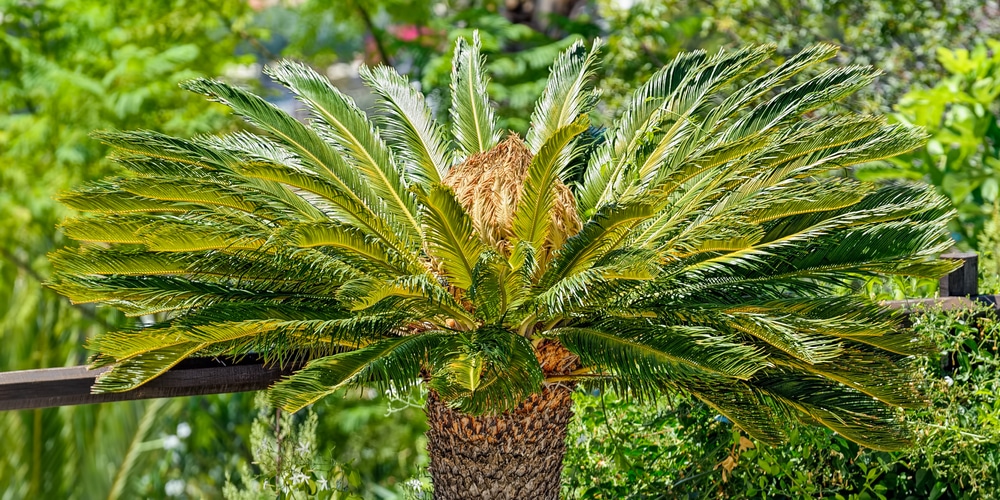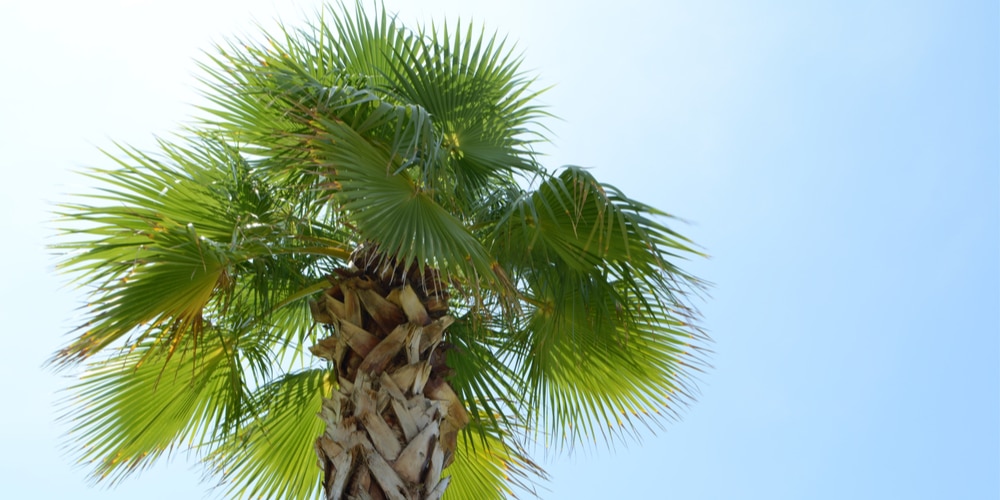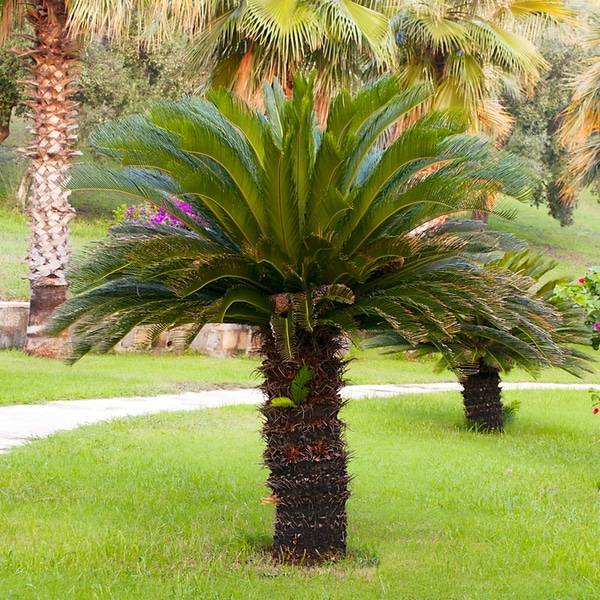Palm trees are breath taking! Imagine an exquisite tropical location where the trees grow tall and powerful, with its broad leaves spread overhead. Just thinking about these trees may make you want to cultivate the plant in your yard. If you’re looking to grow a palm tree you may be wondering, ‘How Long Does it Take for a Palm Tree to Grow?’ Let’s find out!
How Long Does it Take for a Palm Tree to Grow
Depending on the temperature, the type of palm, and current weather conditions in an area, a palm tree’s development pace might vary widely.
But how quickly do the majority of palms grow? How tall are they on average?
Palm trees exist in a broad range of shapes, sizes, and colours.
The development rate of a palm tree varies based on the species. Therefore, this section will cover the top palm species and their average growth rate.
1. Lady Palm
This unique palm tree kind takes a long time to flourish. You should take this into account if you’re aiming to grow it.
Typically, Lady’s palms grow between two and ten inches every year. Soil, temperature, and other factors aren’t exempt from this rule.
Keeping a lady palm indoors delays the plant’s development even more. Even with a conspicuous light source, it still takes a long time to grow.
2. Fan Palm – Mexican
This tree, sometimes known as the Mexican palm, grows steadily at four feet each year. If planted in suitable soil and watered adequately, Fan Palm-Mexican is among the fastest-growing palms.
Mexico is the country of origin for this plant. In California, you’ll also discover a few variations. If you choose to plant your Fan palm anywhere other than one of the sites mentioned above, expect a lengthier development period.
3. The Windmill Palm
With an annual growth rate of 8 inches, the Windmill Palm is one of our list’s most significant palm trees. In addition, the plant’s modest stature makes it ideal for indoor placement.
These palms are also tolerant of a wide range of soil types and levels of hardiness. Outside, the minimum hardiness zone is 8; when it comes to the inside, it’s 4. So unless you put these trees in one of the zones listed above, they will die within a few weeks after being planted. When grown in cold climes, they cannot survive and will become dormant.
4. The Queen and King Palms
The Queen and King’s palms have a 2-foot yearly growth rate in common. Planting these plants is best done in zones 9 to 11, although they may be grown elsewhere. They reach a height of 49 feet when fully grown. However, it will take a long for the plants to reach full maturity.
If you wish to plant King and Queen palms in a cold climate, make sure you do it in a protected location. You should also expect a significant slowdown in growth over the winter months.
5. Foxtails
Foxtails are a common variety of palm trees in Australia, and they grow one foot each year on average. So around 30 feet, on average, are the height of these trees. However, if you keep them indoors, it may reduce this risk. For these palms to grow to their full potential, you need to give them plenty of room.
The Foxtail’s ability to survive cold temperatures is one of its greatest assets. The same goes for temperate and tropical regions. As far as palm trees are concerned, this is a one-of-a-kind trait.
If you’re growing a Foxtail inside, keep in mind that it may not cover the total 30 feet. In addition, must tailor the interior environment to the plant’s pace of growth. When a tree grows to a significant height, it’s evident that you don’t want to remove it.
In the early stages, you may wish to move it outside. It’s easier and less time-consuming to grow this plant outdoors, and it also decreases your care needs.
6. The European Palm
Despite their slower growth rate, these plants remain popular due to their distinctive form and attractive structure. The average height of a European palm is less than 16 feet. Therefore, a low-growing palm tree may be the ideal option for you if you have limited space in your yard.
During the first few years of raising European palms, you’ll be amazed at how quickly they develop. Every year, they’ll gain about 10 inches in length. However, as the plants become older, their growth rate will slow down.
Although the temperature and soil type are appropriate and sunshine and watering requirements are correctly fulfilled, older varieties of these palms barely grow a few inches each year. As a result, you’ll notice a scarcity of foliage as the plant grows. Only one frond is usually grown each year.
The European palm’s ability to withstand the cold is its most important feature. This is a characteristic you won’t find in any other palm trees, and it’s a fantastic one. It can thrive in any climate, unlike other palms. Like Texas, the plant will grow in its designated hardiness zones, even in colder climates.
Because of their perfect height, they are an excellent choice for small to medium-sized gardens. They won’t overshadow your other trees, but they’ll also give just the proper amount of shade, thanks to their height.
What to consider when planting a palm in your yard?
Palms can grow up to 100 feet tall. As a result, you should only plant palm trees in your yard if you have plenty of room for it to grow. It should be clear by now that the pace of growth of palm trees varies according to species. This is in addition to elements such as the plant’s origin, preferred soil type, and the current weather conditions. If the soil is adequately fed and nourished, the growth rate is likely faster and better.
What Can I Do to Accelerate the Growth of My Palm Tree?
Use the following advice to help your palm trees grow quicker for optimum results.
1. Establish a microenvironment
This is a simple approach to speed up the growth of your plant. In addition, the fruiting capacity of the tree may be well-managed thanks to the microenvironment. Finally, planting your tree in the open allows for more natural light, which is why it’s ideal to do so.
Even before you bring your indoor palm indoors, set up some artificial lighting for it.
2. Maintain a comfortable temperature
Another way to help your plants thrive is to fertilise them. When preserved in warm, tropical climates, palm trees flourish to their full potential. In addition, you may create a sense of warmth in your interior palm tree by either putting it outside or using an innovative lighting system.
3. Provide the plant with the nutrients it needs.
If you want to keep the plant growing, you may want to feed it now and again. Create a source of CO2 and nutrition absorption to do this. Can also add the mycorrhizal fungus to the plant’s root. This will speed up the development of the plant even further.
You may further improve the plant’s nutrition by fertilising it regularly. In addition, potassium sulphate can be added to the potting soil to speed up and stabilise development.
Why Do Palm Trees Cost So Much?
The high expense of palm trees can be attributed to the fact that they are frequently imported from other countries. Because of their slow growth rates, the plants are incredibly costly.
How Long Does it Take for a Palm Tree to Grow?: Conclusion
Once you’ve learned all you need to know about palm trees, don’t delay! Purchase your interior or outdoor palm right now! Most palm palms will be easy to manage if you follow the necessary temperature, watering, and soil criteria.


